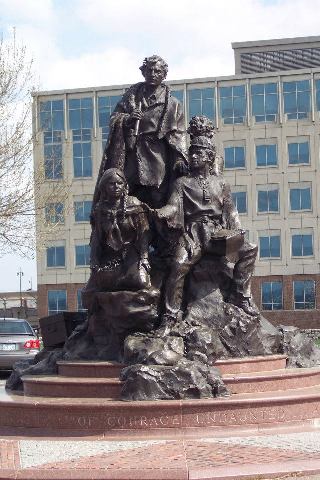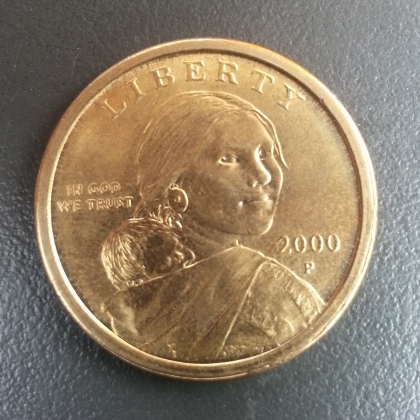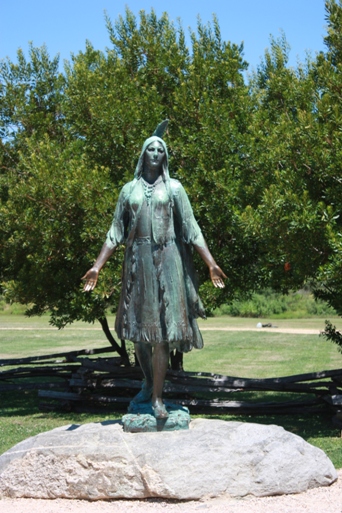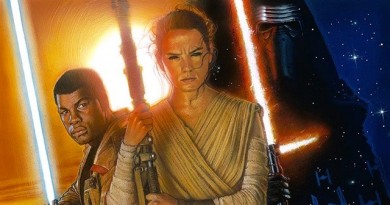Finding What We Need: Native American Heroines and the Creation of Historical Myths
Guest post by Priya Chhaya
“An age finds the heroes it needs…”
Sarasohn, David. 2005. Waiting for Lewis and Clark: The Bicentennial and the Changing West. Portland, Oregon: Oregon Historical Society Press.
Here on FANgirl we talk a lot about heroines – who they are, what makes them strong, how they represent and influence the culture we live in. Often these discussions involve looking at the process of myth-making and storytelling; stereotypes and archetypes – and how they reflect real world needs and ideas. These ideas specifically are rooted in our historical narrative.

For a long time the history we learned was told from a singular perspective: the white male, the victors, the overseers, the husbands. Since the 1960s historians have worked to fill that gap looking at the same history from additional viewpoints including African-American, immigrants, Native-Americans, and women. While we have some primary sources written by members of this specific groups, sometimes our understanding of these lives come from folklore: stories, myths, music, and literature.
Folklore gives us a sense of iconic figures and representations that reflect the age in which they were written. These historical mythologies are transitional and ever shifting from decade to decade, just as our heroes and heroines in science fiction have changed based on where we were in time.
About a month ago I sat down with a friend of mine, Kristina Downs, to talk about her dissertation on Native American heroines. We’ve known each other for about ten years through a mutual love of Shakespeare and science fiction at the College of William and Mary, but it was only recently through a random post on Facebook that I realized she was in the process of getting her Ph.D. in folklore.
Her dissertation looks at four different Native American women: La Malinche, Pocahontas, Sacagawea, St. Kateri Tekakwitha. Each of their stories involve the moment of contact with colonizers, and how that changed the course of their lives. But each became a folk heroine in their own right where their actions became representational for Native interaction during the early years of this country.
Kristy is specifically examining the transformation of their stories over time. For example, how is it that Pocahontas and La Malinche have similar lives but yet are viewed so differently by historians and storytellers (Pocahontas=hero, La Malinche=traitor).
What makes this so hard?
The thing to keep in mind with heroines who are based in history is that we are less likely to have much they left behind in their own voices. With the women I study, none of them left anything in their own words. We also know very little about them, because, for the most part, while they were alive they weren’t considered very important. This makes them very malleable as folk heroines because you can fill in all those gaps with whatever you need to.
This reflects how we look at our heroines in literature. Those we cover here on FANgirl are built up to represent a particular vision of strong – but what we take from them is of our own creation. We fill in the gaps and build out their stories to fit what we need: to be ideals, role models, icons of modern women.
In the interview I ask Kristy about the heroic tradition in America, her dissertation topic, and her favorite heroines real (and fictional).
1. Tell me a about the heroic tradition in America. What are some ways in which our historical heroes evolved over time?
A lot of our folk heroes are borrowed from other cultures, mostly from Europe. Jack from the Appalachian Jack Tales comes from the British Isles, for example. Same with the Appalachian ballad traditions. Now granted, those stories evolved in the U.S. and took on their own qualities, but they were borrowed.
Our historical heroes are a little more distinctly ours. Obviously we’re the only country that can claim George Washington or Abraham Lincoln because they lived here. Sometimes as historic figures become folklorized their stories get molded into pre-existing patterns. I think the exaggeration that happens during the folklorization process is just a natural evolution. Often they symbolize a particular historic moment and we have to imbue them with everything we feel about that moment. George Washington is the father of our country, so he must embody our ideals as a country. What are those…? He was honest; how honest was he? And someone puts in the cherry tree story and it sticks. He was strong; how strong? He could throw a dollar across the Potomac. He could crush a walnut with his bare hands. Maybe there was a grain of truth to some of these anecdotes and they just grew with each retelling, who knows? He’s literally larger than life (read: tall) and we have him standing stoically in the prow of a ship crossing the Delaware, because if he’s the man that led the Continental Army to victory we need him to be strong and fearless.
Each case is a little different. John Smith is a man who really worked hard (and successfully) to make himself into a folk hero. If you read his memoirs it becomes clear John Smith knew a good story when he was making it up. He talks about himself in the third person so it’s really amusing. “And then John Smith saved the colony using only an empty musket and some dried corn. Then some men were mean to John Smith and they were stricken down with the plague…” It obviously worked, because in the twenty-first century we’re still making him the romantic lead in movies.
2. How is this different for our heroines? Why did you choose to look at Native American heroines specifically?
I guess the first big difference with heroines is there are fewer of them. The next big thing to keep in mind with heroines who are based in history is that we are less likely to have much they left behind in their own voices. With the women I study, none of them left anything in their own words. We also know very little about them, because, for the most part, while they were alive they weren’t considered very important. This makes them very malleable as folk heroines because you can fill in all those gaps with whatever you need to.
Another big difference with heroines is that they are generally defined in relation to men. You don’t have a lot of women who have their own stories without some prominent male figure in it. Deborah Sampson might get to keep her own story—she was married, but her husband’s not a huge part of it. Of the women I study, St. Kateri Tekakwitha is the only one not primarily defined through her relationships with European men. Unless you count Jesus, which might be a fair point to argue in her case. Not that Jesus was European, but she was introduced to Christianity by French Jesuits, so it was still European males that were directing her life.
3. You quoted David Sarasohn who said that “An age picks the hero that it needs.” How do you think we choose our heroes today?
Some heroes come in and out of vogue in different time periods and most of the time I think it’s a matter of whether they fit with what people need and want in a hero. A good example is Superman—you could probably argue that he’s the most well-known American comic book hero, but the last couple movies haven’t done well. I have to be honest, I haven’t seen them, so it’s totally possible they’re just bad movies, but I’ve gotten the impression that the studios are sort of fumbling for how to make him “relevant” to today. Meanwhile Iron Man is suddenly more popular than he’s been in a long time (possibly ever). A lot of this is because of Robert Downey Jr., but I think some of it is that the millionaire playboy industrialist is just more appealing to contemporary audiences than the Boy Scout reporter from the Midwest.

This happens with heroes based in history too. Sacagawea didn’t become a folk heroine for about a century after the Corps of Discovery Expedition. Her genesis as a folk heroine was very closely tied with women’s suffrage in Oregon. There was a vote on women’s suffrage in Oregon in 1906, so activists really tried to use the Lewis and Clark Centennial as a venue for getting suffrage arguments out. In a fairly conscious way they promoted Sacagawea as a symbol for suffrage ideals/arguments. The first statue of Sacagawea was put up at the Lewis and Clark Exposition in Portland in 1905 and Susan B. Anthony was the keynote speaker. For the suffrage activists at that time she was exactly the heroine they needed. She was a woman who had ties to Oregon’s history and in particular this foundational myth for the region. She was a mother—suffrage activists often used the argument that because women were mothers they had a special interest in the future of the nation. These activists wound up shaping the way we see Sacagawea to this very day.
Even if a hero stays popular for several generations in a row, they typically evolve. Pocahontas was more maternal when she first became popular. The maternal role was largely taken away from her in the years leading up to the Civil War in an attempt to de-legitimize Virginia. In the years leading up to the First World War she was evoked often as a sort of peace activist. Then, seemingly out of nowhere, in the 1920s she becomes a flapper: she’s hustling John Smith at poker, smoking cigars, and telling her dad that “Indian braves don’t satisfy.” All of these things were clear reactions to what was happening at the time. People just remade her into whoever they needed her to be. A friend just sent me a photo of an awesome hipster Pocahontas at DragonCon holding a sign that said, “I was American before it was cool.” Another great example of reshaping a heroine to get across a specific message.
4. What about today?
In some sense, today the media controls our selection of heroes. They pick who to make a hero, but whether it’s the twenty-four hour news cycle or just different outlets trying to one-up each other, there’s also a push to find out everything about a person. The fact is that there aren’t a lot of us who would stand up well to that kind of scrutiny. So all our heroes get torn down eventually. It’s not that people are less perfect than they used to be, it’s just that it’s so much easier to get ahold of and disseminate information. Even the heroes that we’ve had for generations, we’ve uncovered all their dirty secrets and it gets hard to see them as such heroes. If I may quote Malcolm Reynolds, “every man ever got a statue made of him was one kind of sumbitch or another.” I think that’s why a lot of American heroes these days are either vague figures like “The American Soldier” this sort of faceless ideal or they don’t last long.
5. Does your research effect how you look at women in science fiction and fantasy? Do you find yourself seeing patterns in literature and movies that you see in your study of folklore?
It definitely does. I’ll be honest, like most scholars I think there are times that I wish I could shut the academic off. With fantasy in particular there are a lot of times where I feel like Edward Said is looking over my shoulder. I guess this is why it’s important in academia to do what you love—it follows you everywhere.
To some extent, the dangerous thing about patterns is that once you have one, you can make any story fit it if you try hard enough (although, often the text will push back). But yes, I do see patterns. Probably the clearest example I can think of is Sharon in Battlestar Galactica (Caprica Sharon or Athena or whatever we’re going to call her). Her story basically follows the same narrative pattern as the women I study: It takes place during a moment of cultural contact (I suppose these two cultures have been aware of each other for quite some time, but they’ve only just come back into contact once the story begins.), she falls in love with a man from the other culture, saves his life, helps him to survive by providing important knowledge, ultimately picks his culture over her own, and has a biracial child. The big key deviation is that she doesn’t die young (well, I suppose she does, but death is less permanent for her). She’s even brown skinned. Now, I don’t think for a second that the writers of BSG sat down and thought, “Let’s make Sharon’s story like Pocahontas.” And I think in the context of the show, bringing Grace Park’s race into it can be seen as over reading, but it is there. I do think it shows how engrained this pattern is. Why is it so often women who act as these cultural bridges? This is what I’m trying to figure out in my research—I really don’t have the answer yet. (I also realize you could argue some similar things about Tyrol, but it’s even more of a stretch there.)
6. Who are your favorite heroines real and fictional? Why?
Wow. This is a much harder question than it should be considering what I do for a “living.” I guess there’s just such a wide range to choose from and it also depends what you mean by “heroine” and what you mean by “favorite.” The characters I find most entertaining aren’t always ones I want to have coffee with, if that makes any sense. This is also one of those times when I really want to shut up the academic in my brain, because there’s always that voice asking, “Am I allowed to like this heroine? Is there some sort of patriarchal discourse reaffirmed in her narrative? Or am I exoticizing the other? Will I reveal myself as a fan of mediocre fiction?” So I’m going to do my best to ignore that voice and just give you an honest answer.

On the Legendary/Mytho-historic front I’d like to offer up Rhiannon from the Welsh Mabinogi. The characters in the Mabinogi are surprisingly well-rounded in general for epics/legend cycles and there are a lot of great female characters in it. Rhiannon first appears riding a horse and our hero is so stricken with her he goes riding after her, but no matter how fast he rides he can’t catch her. Night after night this happens until finally he just calls out, asking her to stop. She does, but when she turns around she says, “You know, it would have been better for your horse if you had asked me sooner.” All our talk about consent we’re still having today, and here you have this medieval text where a woman’s like, “Hey, if you want a woman to do something, ask.” She also calls her husband stupid at one point, she’s just fabulous. Sure, she has some low moments, but who doesn’t?
One of my favorite historical figures is Catalina de Erauso; I’m not sure she qualifies as a heroine or an anti-heroine. She was definitely not a proper lady. Her memoirs (the “authenticity” of which are questionable) are published in English as Lieutenant Nun: Memoirs of a Basque Transvestite in the New World. Talk about a woman who broke with tradition! She fled a convent in Spain, disguised herself as a man, and went to South America to seek her fortune. She has these crazy quixotic adventures, gets herself into all sorts of trouble, but gets herself out of it as well. I love that she never needs a man to rescue her.
Fourteen year-old me demands that I mention Elektra (Daredevil’s femme fatale, not the figure from Greek drama). Teenaged me was obsessed with her. (Please note: this was before the movie, which I have never seen.) Why it was so cool to kill a bunch of street thugs and write “I love NY” with their blood on the wall, I really couldn’t tell you. It probably doesn’t take any skill as a psychoanalyst to see why an awkward teenaged girl who was horribly bullied found appeal in the figure of a woman who could kick anyone’s ass she wanted. My obsession has waned quite a bit over the years, but maybe not as much as sophisticated academic-me would like to believe. There was a weird day last semester when two different people, both unaware of my old obsession, in unrelated conversations told me that I would make an excellent ninja assassin (actually one expressed his suspicion I secretly am one). I’m not going to lie—made my week. Maybe she’s still more my hero than I care to admit.
And because, for all my academic training, inside I’m still a cliché of a fourteen year-old girl, I really like Katniss Everdeen. I’m going to embrace it. I can’t say that I have a lot in common with her beyond a first initial and an underdeveloped self-preservation instinct, but I like her. I like that she’s good at killing things. I like that while she isn’t always the smartest character around, her loyalty to those she loves outweighs her other failings. Heck, I like that even if she doesn’t really want to, she gets excited over occasionally getting to wear a pretty dress. Being an admitted “girly girl” myself, I’ve often been frustrated by all the messages that as a woman if you want to be tough you have to stop being feminine. I like that femininity is never treated as a weakness in her narrative.
Probably today (emphasis on today, because it could change by tomorrow) my favorite fictional heroine is more in the direction of Veronica Mars. On the surface, she’s who I am in my greatest dreams. Tough, smarter than everyone, and always ready with the perfect comeback. Inside, she’s a train wreck. Honestly, I think that probably resonates for a lot of women. For all the things we do “right”, many of us find ourselves falling into patterns we would scold our friends for whether it’s dating self-destructive guys or obsessing over the things we can’t change. I would totally have coffee with Veronica Mars.
La Malinche: The woman called La Malinche was born to a Nahuatl (that’s the language spoken by the people often called “the Aztecs”) speaking group sometime in the late fifteenth or early sixteenth century. Her actual name is unknown—Malinche is what she was called in Spanish accounts and it’s generally believed to be a Spanish adaptation of a Mesoamerican word. Many people have connected it to the Nahuatl names Malinali or Malintzin. Whatever her name was, she was sold into slavery to the Chontal Maya, probably as a result of some sort of inheritance dispute in her family. When Hernán Cortés landed in the Yucatán Peninsula, she was part of a group of women given to the Spanish as tribute. Cortés realized she spoke both Maya and Nahuatl which would be helpful in his coming campaign against the Mexica Empire (again, that’s Aztec). Cortés had in his party a man who spoke Spanish and Maya, but no one who spoke Nahuatl. During the Conquest of Mexico Malinche translated from Nahuatl to Maya so that the Maya could be translated into Spanish for Cortés. She also became Cortés’s lover and bore him a son, Martín, and converted to Catholicism, taking the new name Marina. After the conquest she was married to one of Cortés’s lieutenants, gave birth to a daughter, and is believed to have died by the age of 30.
Pocahontas: Pocahontas, whose name was Matoaka or Amonute, was born in the late sixteenth Century, daughter of the Paramount Chief of several allied Algonquin groups. She was about eleven years old when she first met John Smith. Although historians generally agree that the famous incident in which she saved his life was either a misunderstanding or a fictionalization
She did act as an emissary between her people and the Jamestown settlers, probably aiding in the colony’s survival.In 1613 she was kidnapped by the English Captain Argall who attempted to ransom her for the return of English captives and weapons. Her father did not meet the full demands and she remained prisoner at Fort Henricus where she met and eventually married John Rolfe. Their son Thomas was born in 1615. She also converted to Christianity, taking the name Rebecca. Rebecca and John Rolfe traveled to England where she was welcomed as a combination curiosity and dignitary. Sadly she died just as they were beginning their return journey to Virginia at the age of twenty-two.
Kateri Tekakwitha: Kateri Tekakwitha, often referred to as the “Lily of the Mohawks,” was born in 1656 in Ossemonon in what was then New France and is now upstate New York to a Catholic Algonquin woman and a Mohawk chief. Four years later a small pox epidemic killed her parents and brother and left her with scars on her face. She converted to Catholicism herself as an adolescent and after her Uncle pressured her to marry despite her vow of virginity, she joined the French Jesuit mission at Kahnawake, in what is now Québec. There she devoted herself to acts of mortification such as sleeping on a bed of thorns and prolonged fasting. She died at the age of twenty-four and it was widely reported that the smallpox scars disappeared from her corpse. She is also said to have appeared to several people in the village, assuring them she was in heaven. In 2006 she is believed to have healed a 6 year old boy from the Lummi tribe of necrotizing fasciitis. She was canonized in October of last year.
Sacagewa: Sacagawea was born around 1788 in what is now Idaho to a Lemhi Shoshone tribe. At the age of twelve she was kidnapped by the Hidatsa and a few years later she married French-Canadian fur trapper, Toussaint Charbonneau. According to some accounts he purchased her from the Hidatsa; according to others he won her in some sort of game. When Charbonneau was hired in 1804 to help guide the Corps of Discovery Expedition led by Lewis & Clark on their way to the Pacific, the pregnant Sacagawea came with him. Her son Jean-Baptiste, nicknamed Pompey, was born on the journey. Throughout the expedition she proved at least as helpful as her husband, if not more, due to her knowledge of the terrain and ability to communicate with the tribes they encountered. One of these tribes was a Shoshone group led by her own brother, Chief Cameahwait. Very little is known about her life after the Expedition, but she is most commonly believed to have died in December of 1812 at about the age of twenty-four. We know for certain that by 1813 her son Pompey and infant daughter were officially in the guardianship of William Clark.
Kristina Downs (@LeapingPrincess on Twitter ) is a doctoral candidate in the Department of Folklore and Ethnomusicology at Indiana University. Her dissertation examines representations of Native American heroines in North America as a means of understanding colonialism and national identity. She also holds a Master’s degree in Folklore from George Mason University and a BA in Latin American Studies from the College of William and Mary.
Priya Chhaya is a historian who loves the written word. When she’s not reading anything she can get her hands on she is writing about the past and its intersection in our daily lives on her personal blog …this is what comes next.
- Imagining a New World at FUTURES - January 10, 2022
- Escape to WandaVision - February 24, 2021
- Regency Daze and the Magic of an RPG - January 5, 2020












Pingback:Finding What We Need: Native American Heroines and the Creation of Historical Myths | ...this is what comes next
Pingback:One Step: From 2013 to 2014 | ...this is what comes next